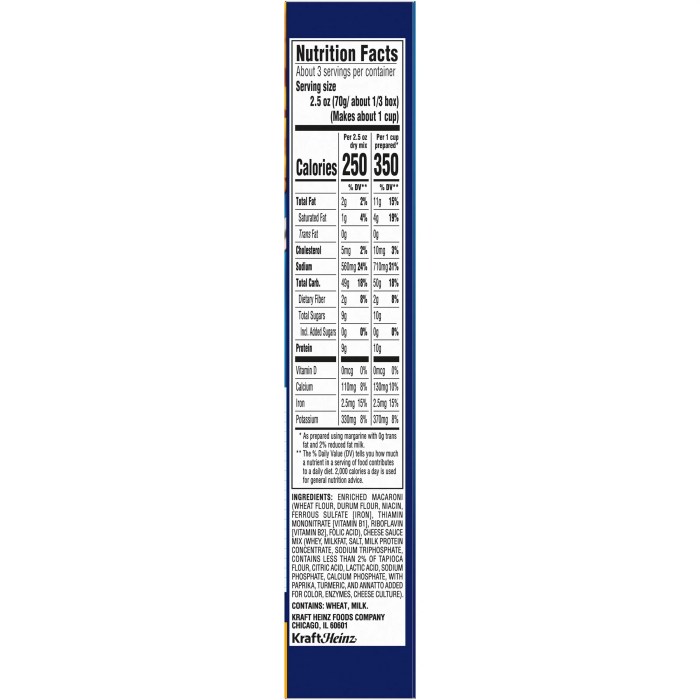Serving Size and Calorie Information: Kraft Mac N Cheese Nutrition Label

Kraft mac n cheese nutrition label – Understanding the serving size and calorie content of Kraft Mac & Cheese is crucial for managing your daily caloric intake and making informed dietary choices. The nutrition label provides a standardized serving size, allowing for consistent comparison with other foods. However, it’s important to remember that calorie counts can fluctuate based on portion size and the addition of other ingredients.A standard serving of Kraft Mac & Cheese, as indicated on the nutrition label, typically equates to approximately one cup (227g) and contains around 280 calories.
This value represents the calories present in the prepared mac and cheese as per the package instructions. Consuming a larger or smaller portion will directly impact the total calorie intake. For example, doubling the serving size to two cups would roughly double the calorie count to approximately 560 calories. Conversely, eating only half a serving would result in approximately 140 calories.
Calorie Variations Based on Serving Size and Added Ingredients, Kraft mac n cheese nutrition label
The calorie count of Kraft Mac & Cheese is directly proportional to the serving size. A larger serving means more calories. Adding ingredients such as meat or vegetables further alters the calorie count. For instance, adding a half-cup of cooked ground beef (approximately 150 calories) to a standard serving of Kraft Mac & Cheese would increase the total calorie count to approximately 430 calories (280 + 150).
Checking a Kraft Mac & Cheese nutrition label often reveals a surprising amount of sodium. For a healthier alternative, you might consider the nutritional information found at panera macaroni and cheese nutrition , but remember that even seemingly healthier options can have hidden calories. Ultimately, mindful portion control is key when enjoying any mac and cheese, regardless of brand.
Similarly, incorporating a cup of steamed broccoli (approximately 55 calories) would result in a total of approximately 335 calories (280 + 55). These are estimates, and the exact calorie increase will depend on the specific ingredients and their quantities. It’s always recommended to consult a nutrition database or food label for precise calorie information of added ingredients.
Comparison to Other Meal Options

Kraft Mac & Cheese, while convenient and undeniably delicious, occupies a specific niche in the culinary landscape. Understanding its nutritional profile relative to other meal choices is crucial for making informed dietary decisions. This comparison will examine Kraft Mac & Cheese against a homemade version and highlight key differences in nutritional content and sodium levels.
A direct comparison reveals significant variations between Kraft Mac & Cheese and a homemade alternative. While both provide carbohydrates and some protein, the homemade version offers greater control over ingredients and allows for the inclusion of healthier components like whole wheat pasta, reduced-fat cheese, and added vegetables. This flexibility allows for a nutritional profile significantly different from the processed version.
Nutritional Value Comparison
The primary differences lie in the fat, sodium, and fiber content. Kraft Mac & Cheese typically contains higher levels of saturated fat and sodium due to the processed cheese powder and added salt. A homemade version, using whole wheat pasta and reduced-fat cheese, can significantly lower these levels. Furthermore, the homemade option allows for the addition of vegetables, boosting the fiber and vitamin content, aspects largely absent in the processed version.
Conversely, the convenience and readily available nature of Kraft Mac & Cheese provides a quick and easy meal solution, particularly beneficial for busy lifestyles.
Sodium Content Analysis
Sodium content is a significant area of divergence. Processed foods, including Kraft Mac & Cheese, often contain substantially higher levels of sodium than homemade meals. This is primarily due to the addition of sodium as a preservative and flavor enhancer. Reducing sodium intake is often recommended for maintaining heart health, making the higher sodium content of Kraft Mac & Cheese a potential concern for individuals monitoring their sodium levels.
A homemade version, using unsalted butter and reduced-sodium cheese, allows for precise control over sodium intake, offering a healthier alternative for those seeking to lower their sodium consumption. For example, a single serving of Kraft Mac & Cheese can contain over 600mg of sodium, while a comparable homemade portion could contain significantly less, depending on the ingredients used.
Comparative Nutritional Data
The following table summarizes the key nutritional differences between Kraft Mac & Cheese and a homemade version, assuming similar serving sizes. Note that values are approximate and can vary based on specific recipes and brands.
| Nutritional Aspect | Kraft Mac & Cheese (per serving, approximate) | Homemade Mac & Cheese (per serving, approximate) |
|---|---|---|
| Calories | 200-250 | 250-350 (depending on ingredients) |
| Fat (grams) | 8-10 (high in saturated fat) | 5-8 (potential for lower saturated fat) |
| Sodium (mg) | 600+ | 100-300 (significantly lower) |
| Fiber (grams) | Low | Moderate to High (depending on pasta and added vegetables) |
| Protein (grams) | 5-7 | 6-10 (depending on cheese and pasta type) |
General Inquiries
Is Kraft Mac & Cheese a good source of protein?
While it contains some protein, Kraft Mac & Cheese is not considered a significant source of high-quality protein compared to other food options.
Does Kraft Mac & Cheese contain gluten?
Yes, Kraft Mac & Cheese contains wheat, a source of gluten. It is not suitable for individuals with celiac disease or gluten intolerance.
How much sodium is in a serving of Kraft Mac & Cheese?
The sodium content varies depending on the serving size, but it is generally high. Check the nutrition label for the specific amount per serving.
Can I make Kraft Mac & Cheese healthier?
Adding vegetables, lean protein, and reducing the amount of butter or milk used during preparation can improve the nutritional profile.


